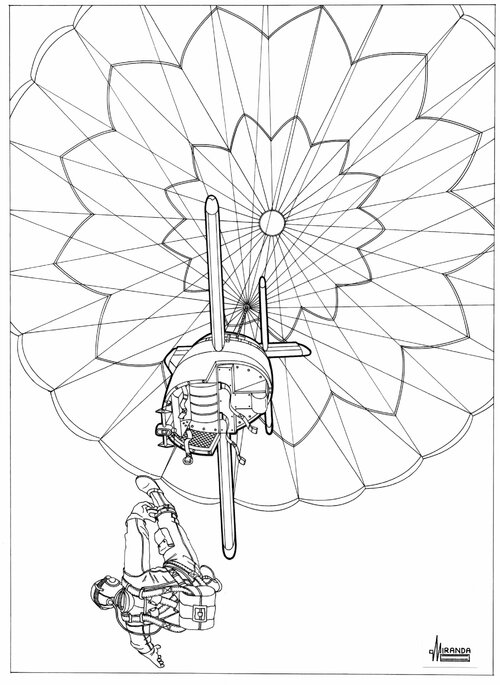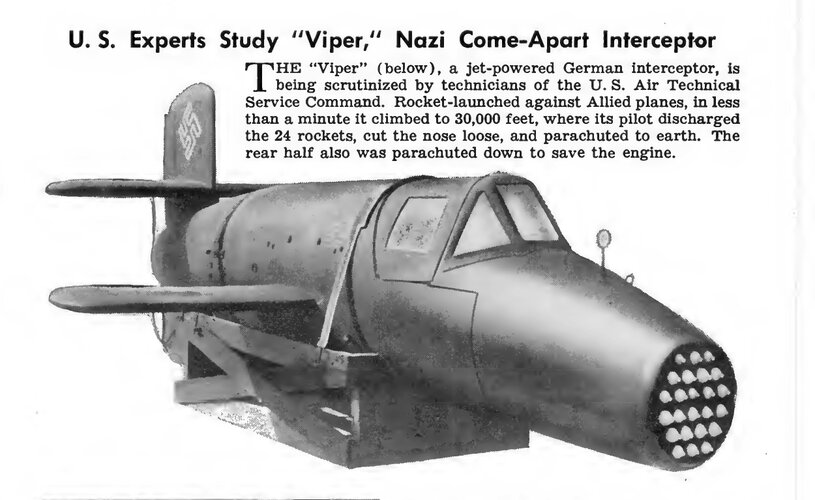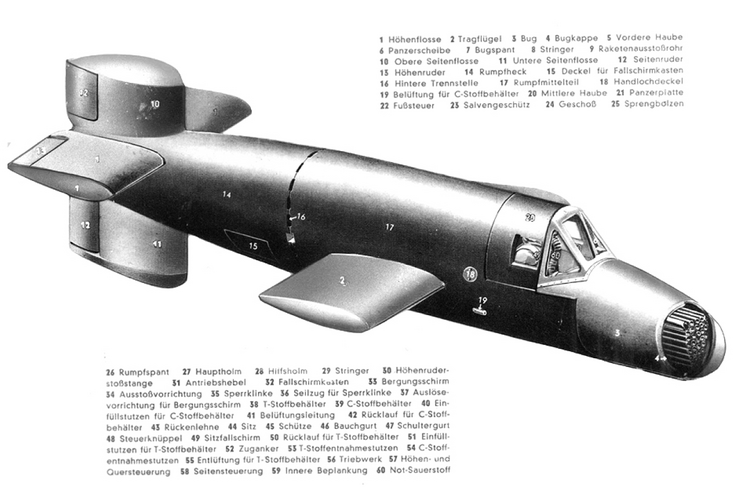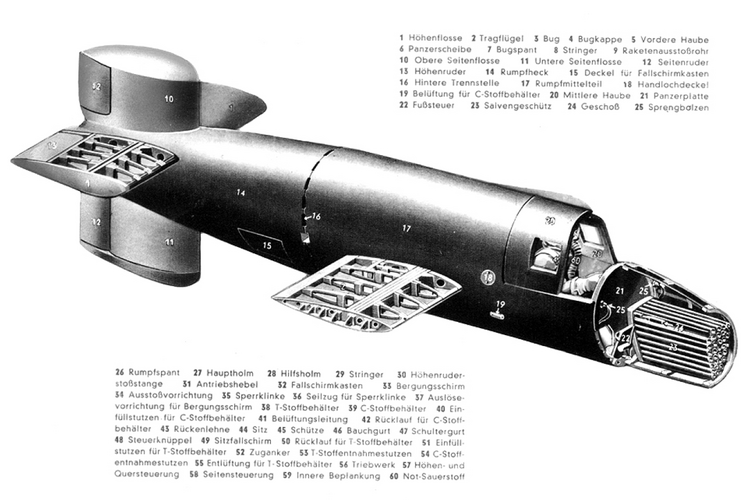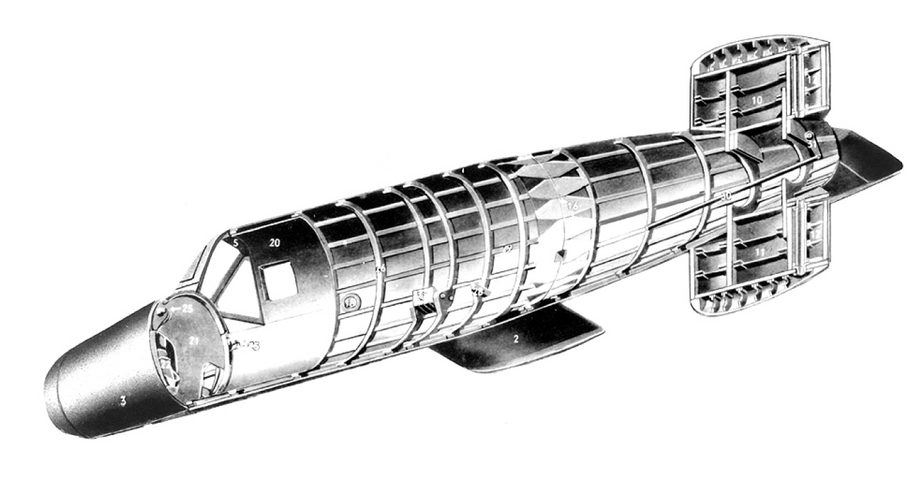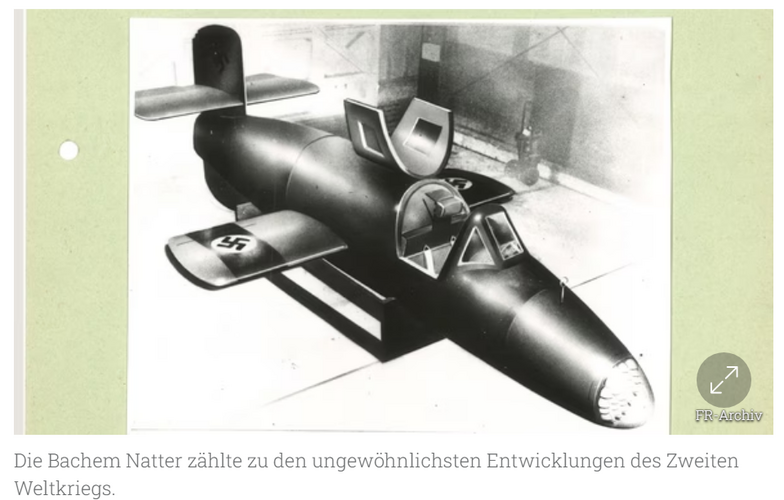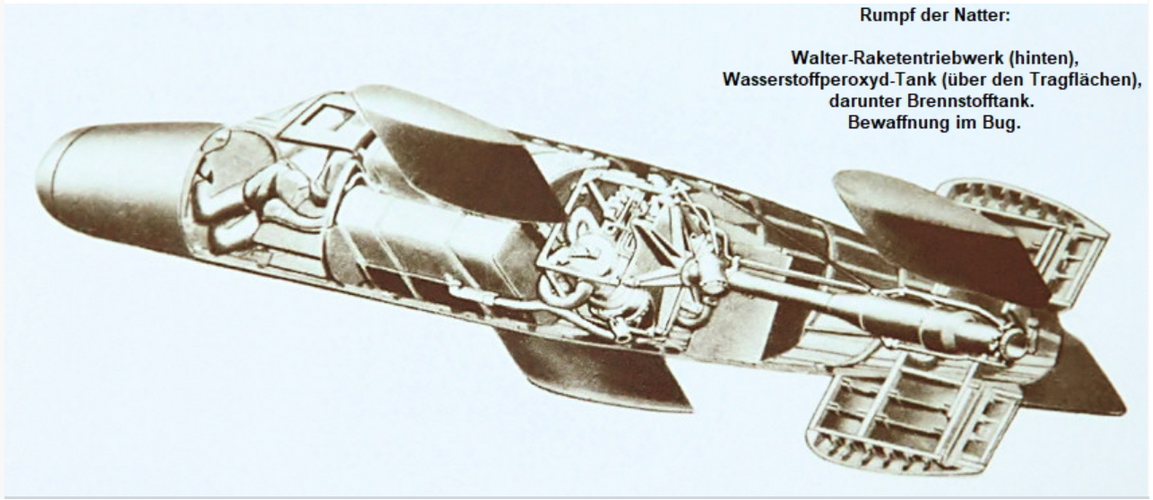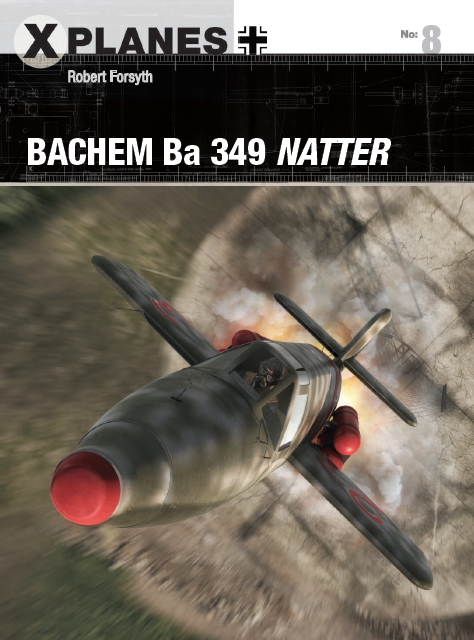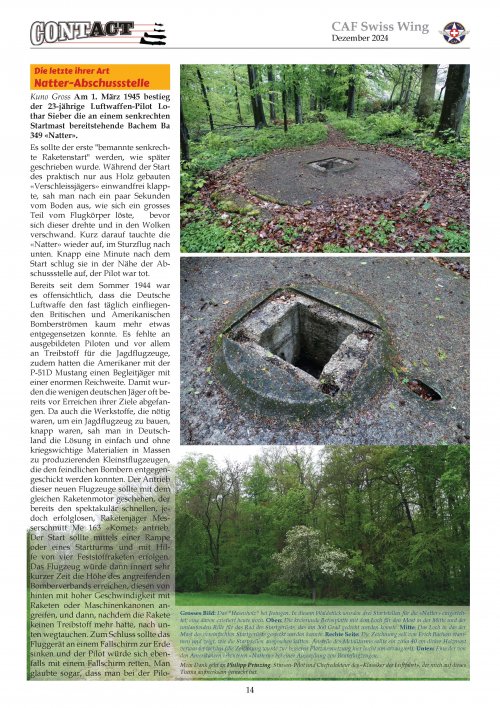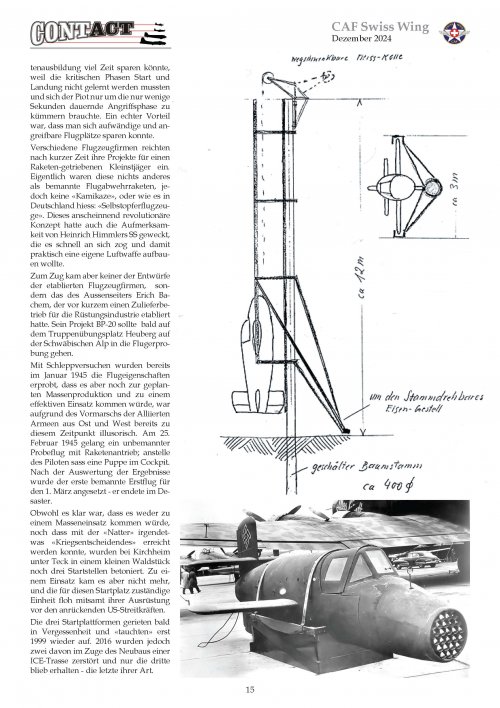two different bookFirst edition 2006Justo,
The cover you show is not the same as the new book.
You are using an out of date browser. It may not display this or other websites correctly.
You should upgrade or use an alternative browser.
You should upgrade or use an alternative browser.
Bachem Ba 349 "Natter"
- Thread starter Michel Van
- Start date
OKtwo different bookFirst edition 2006Justo,
The cover you show is not the same as the new book.
You are not necessarily right:noProbable he broke the sound barrel in his vertical fall
the Walter engine and the four Schmidding SG34 solids had not enough thrust for that
and maximum speed were expected around 800km/h after take off
"The Luftwaffe test pilot Lothar Sieber (7 April 1922 – 1 March 1945) may have inadvertently become the first man to break the sound barrier on 1 March 1945. This occurred while he was piloting a Bachem Ba 349 "Natter" for the first manned vertical takeoff of a rocket in history. In 55 seconds, he traveled a total of 14 km (8.7 miles)."
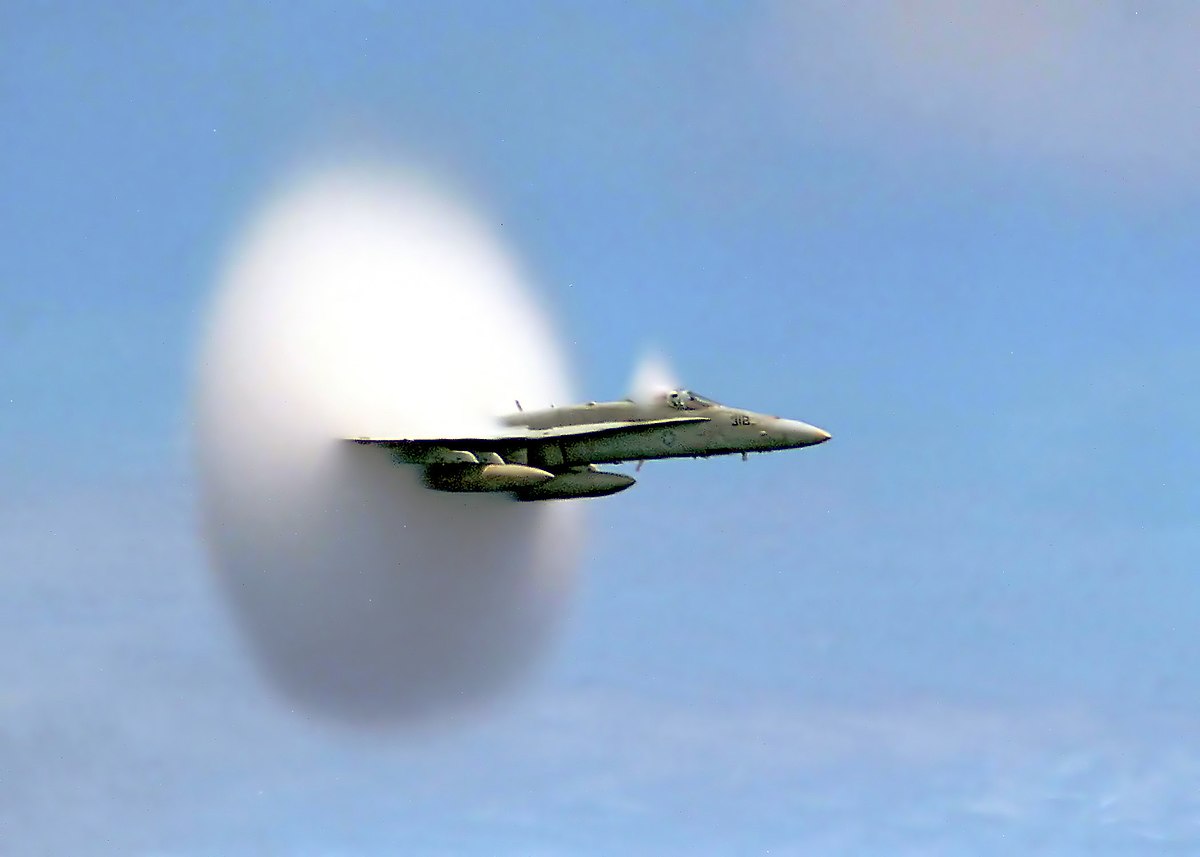
Sound barrier - Wikipedia
en.wikipedia.org
"The Walter liquid-fueled rocket motor built up to full thrust and Sieber pushed the button to ignite the four solid boosters. Initially, it rose vertically. at an altitude of about 100 to 150 m (330 to 490 ft), the Natter suddenly pitched up into an inverted curve at about 30° to the vertical. At about 500 m (1,600 ft) the cockpit canopy was seen to fly off. The Natter continued to climb at high speed at an angle of 15° from the horizontal and disappeared into the clouds. The Walter motor stalled about 15 seconds after take-off. It is estimated the Natter reached 1,500 m (4,900 ft), at which point it nose-dived and hit the ground with great force about 32 seconds later, some kilometres from the launch site. Unknown at the time, one of the Schmidding boosters failed to jettison and its remains were dug up at the crash site in 1998."
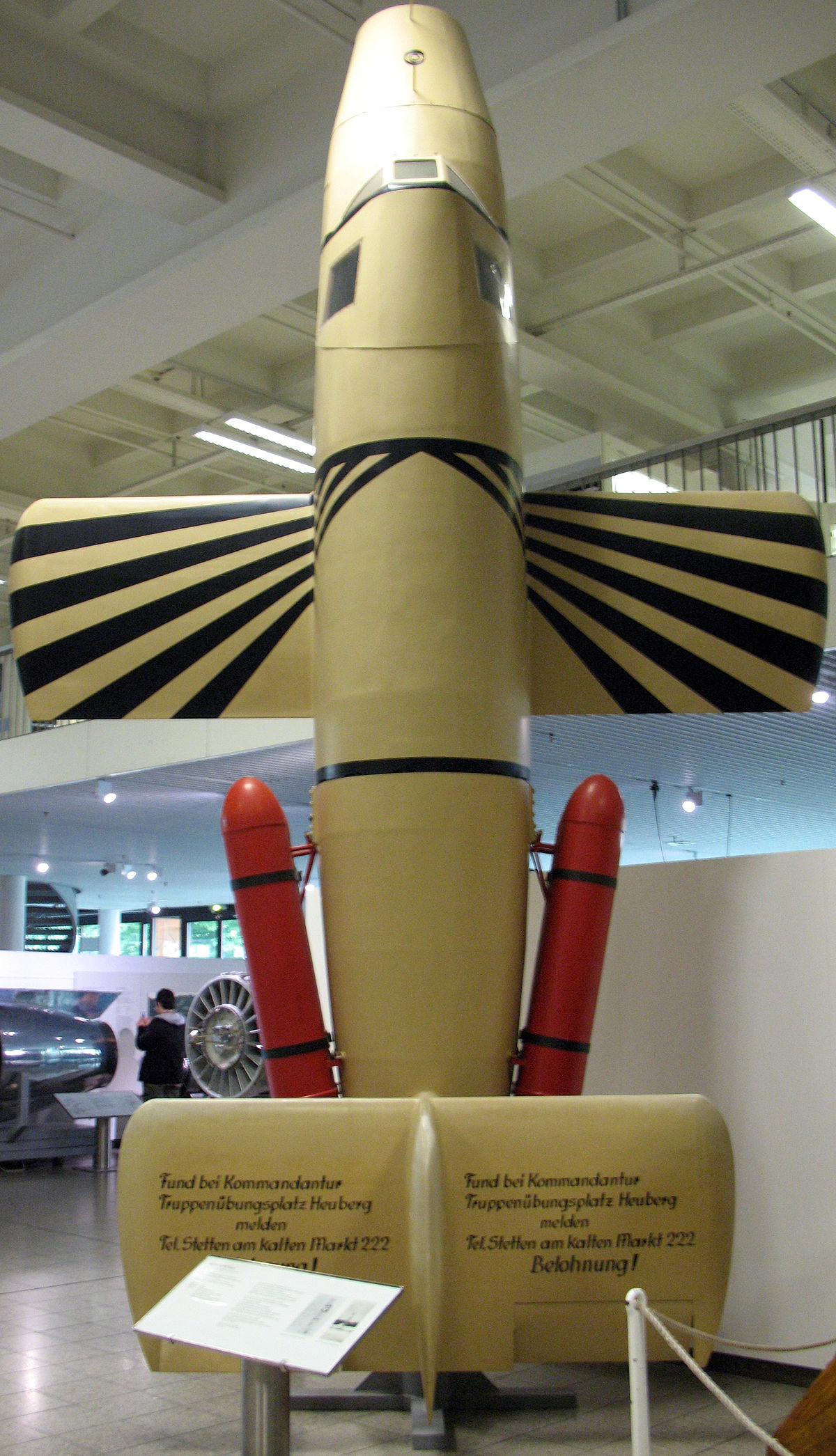
Bachem Ba 349 Natter - Wikipedia
en.wikipedia.org
The Walter engine has 2000kg and the four Schmidding boosters 4x500kg thrust, but the Natter weighs only 2232kg. This is 1,792 thrust/weight ratio against the Bell XS-1's 0,495 value. OK, I know the Natter has worse aerodinamic design and was a subsonic plane, but not impossible.
Here is another article about this deadly flight:
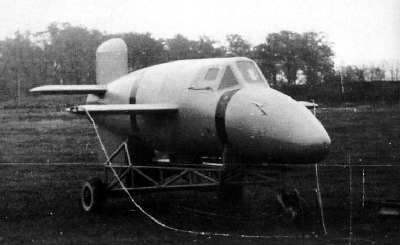
Historical Footnote: On March 1st 1945, did Lothar Sieber become the first person to break the sound barrier?
Yes, it’s true, Chuck Yaeger probably wasn’t the first person to break the sound barrier in manned flight. On a cloudy day in 1945, accomplished test pilot Lothar Sieber flew a Natter …united-cats.com
(It wasn't the only event, because Mano Ziegler reported his friend Heini Dittmar's famous flight on 6 July 1944 in the Me 163V-18 (VA+SP) at a speed of 1,130km/h. And Hans Guido Mutke claimed to have broke the sound barrier with his Me 262 on 9 April 1945 also. Without knowledge of the exact flight altitude, among other things, have not been proven.)
But would one call the Natter launch "flight" in the usual sense of the word--controlled flight? The descriptions sound more ballistic than aerodynamic.
I'm also skeptical about other wartime claims. Transonic aerodynamics were not well understood and measurement instrumentation was unreliable at the time. You still see claims of 500+ mph flight by P-47s, for example. The Me 163 and 262 seem like particularly unpromising shapes from a drag ans stability point of view.
The Me 163 could reach 621 mph. Compression was well understood. The Me 262 had leading-edge slats to improve high speed handling. The sweep back also delayed compressibility. A captured film shows the Me 163 climbing at an 80 degree angle. The Natter was not just tested once. As a rocket propelled point interceptor, it reached altitude and fired its rockets or cannons, and on the way down, a lever was pulled as the aircraft fell to earth, releasing a portion and leaving the pilot free to parachute to the ground. I have seen a photo of a field filled with completed Natters. US soldiers/intelligence were very interested in this aircraft. In fact, it received the first FE or Foreign Equipment number, FE-1/T-2 1.
I'm quite familiar with the Natter and the Me 163.The Me 163 could reach 621 mph. Compression was well understood. The Me 262 had leading-edge slats to improve high speed handling. The sweep back also delayed compressibility. A captured film shows the Me 163 climbing at an 80 degree angle. The Natter was not just tested once. As a rocket propelled point interceptor, it reached altitude and fired its rockets or cannons, and on the way down, a lever was pulled as the aircraft fell to earth, releasing a portion and leaving the pilot free to parachute to the ground. I have seen a photo of a field filled with completed Natters. US soldiers/intelligence were very interested in this aircraft. In fact, it received the first FE or Foreign Equipment number, FE-1/T-2 1.
windswords
ACCESS: Secret
- Joined
- 19 May 2009
- Messages
- 389
- Reaction score
- 218
According to https://www.calculatorsoup.com/calculators/math/speed-distance-time-calculator.php
the speed reached was 569.5 mph or 916.36 Kph. Of course the speed was not constant for the whole distance, but also no one claimed to hear a sonic boom.
the speed reached was 569.5 mph or 916.36 Kph. Of course the speed was not constant for the whole distance, but also no one claimed to hear a sonic boom.
Grzesio
ACCESS: Secret
There are no documents supporting the claim, the Me 163 BV 18 has ever reached 1130 km/h.
The loss of the rudder documented with photos, which allegedly occured during this flight, actually took place on another occasion and at much lower speed.
The loss of the rudder documented with photos, which allegedly occured during this flight, actually took place on another occasion and at much lower speed.
kaiserd
I really should change my personal text
- Joined
- 25 October 2013
- Messages
- 1,657
- Reaction score
- 1,726
Claims of achieving supersonic speed re: the Natter (or Komet or other WW2 German jets and rocket aircraft that actually flew) have little to no credibility.
Right up there with claims of a Nazi Germany nuclear bomb, another claim/ theory which perhaps not coincidentally is also being pushed by some of the same contributors, and perhaps gives some context for how seriously the supersonic claims should be taken.
Right up there with claims of a Nazi Germany nuclear bomb, another claim/ theory which perhaps not coincidentally is also being pushed by some of the same contributors, and perhaps gives some context for how seriously the supersonic claims should be taken.
ubekistano
ACCESS: Restricted
- Joined
- 18 July 2020
- Messages
- 2
- Reaction score
- 0
Maybe he broke the sound barrierThe Bachem Ba 349 "NATTER"
was one of unusual Aircraft Project
Conceive as point-defence rocket powered interceptor, build mostly from oak wood & plywood
using one Walter HWK 109-509 A2 rocket motor and 4x Schmidding SG34 solid rocket boosters for vertical liftoff
It had ahead for it time, a Radar guide remote control who bring the Ba 349 close to Enemy Bomber fleet,
Were the Pilot take over the control and attack the Bomber fleet with 24x RZ 73 „Föhn“ or 33x R4M “Orkan“ unguided rockets.
After attack the Pilot goes in dive, shut down the Walter engine and deployed a parachute,
here the Ba 349 start separate into pieces, first the nose section of the Natter, then the Pilot and the fuselage with engine.
they all land with parachute and are collected. The BA 349 is refurnish, put together and installed on Launch pad.
on 25 February 1944 the first manned Launch of Natter take place (under allot of Pressure by SS and RLM in Berlin).
The volunteer Luftwaffe test pilot, Lothar Sieber. Take off with Natter test Model 23
but at high of 150 meter the M23 pitched backwards, then at 500 meter high, canopy is rip off from aircraft,
then the Aircraft disappear into cloud layer then dive vertical down and Crash, killing Sieber.
Official the SS declare the crash to failure of canopy lash on Be 349.
in-official there were several factors who lead to the crash,
during the Launch of M23 one of Schmidding SG34 failed to jettison ( its remains were dug up at the crash site in 1998)
also was consider that moment the canopy is rip off, Sibel was knockout or even his neck broken,
as the pilot’s head would have snapped back at event.
but there is interesting little know detail:
a group of Children watch the crash, one of eyewitness explain in TV-Doku the events
we were playing football as we hear a explosion in the sky,
as we look up, this airplane [the Be 349] shoot over us down and crash in the woods.
we run to site but we found only a burring crater and tiny pieces.
then the military came...
this is give a new insight: a explosion before the crash, could have the Walter engine failed ?
Source on Eyewitness is german ZDF TV-Doku "Projekt Natter".
(odd i not find any data about the Natter in this Forum, why ?)
Armin Derer
In dire need for coffee
- Joined
- 10 June 2021
- Messages
- 70
- Reaction score
- 99
taildragger
You can count on me - I won a contest
- Joined
- 2 November 2008
- Messages
- 404
- Reaction score
- 502
Eyewitness accounts, especially of startling events like an aircraft diving into the ground, are notoriously unreliable. Given that this account is based on a childhood memory from at least 10 years earlier (and even 1954 would have been very early for a TV documentary), I don't think much weight can be put on it.Maybe he broke the sound barrierThe Bachem Ba 349 "NATTER"
was one of unusual Aircraft Project
Conceive as point-defence rocket powered interceptor, build mostly from oak wood & plywood
using one Walter HWK 109-509 A2 rocket motor and 4x Schmidding SG34 solid rocket boosters for vertical liftoff
It had ahead for it time, a Radar guide remote control who bring the Ba 349 close to Enemy Bomber fleet,
Were the Pilot take over the control and attack the Bomber fleet with 24x RZ 73 „Föhn“ or 33x R4M “Orkan“ unguided rockets.
After attack the Pilot goes in dive, shut down the Walter engine and deployed a parachute,
here the Ba 349 start separate into pieces, first the nose section of the Natter, then the Pilot and the fuselage with engine.
they all land with parachute and are collected. The BA 349 is refurnish, put together and installed on Launch pad.
on 25 February 1944 the first manned Launch of Natter take place (under allot of Pressure by SS and RLM in Berlin).
The volunteer Luftwaffe test pilot, Lothar Sieber. Take off with Natter test Model 23
but at high of 150 meter the M23 pitched backwards, then at 500 meter high, canopy is rip off from aircraft,
then the Aircraft disappear into cloud layer then dive vertical down and Crash, killing Sieber.
Official the SS declare the crash to failure of canopy lash on Be 349.
in-official there were several factors who lead to the crash,
during the Launch of M23 one of Schmidding SG34 failed to jettison ( its remains were dug up at the crash site in 1998)
also was consider that moment the canopy is rip off, Sibel was knockout or even his neck broken,
as the pilot’s head would have snapped back at event.
but there is interesting little know detail:
a group of Children watch the crash, one of eyewitness explain in TV-Doku the events
we were playing football as we hear a explosion in the sky,
as we look up, this airplane [the Be 349] shoot over us down and crash in the woods.
we run to site but we found only a burring crater and tiny pieces.
then the military came...
this is give a new insight: a explosion before the crash, could have the Walter engine failed ?
Source on Eyewitness is german ZDF TV-Doku "Projekt Natter".
(odd i not find any data about the Natter in this Forum, why ?)
Last edited:
- Joined
- 13 August 2007
- Messages
- 8,456
- Reaction score
- 11,039
to make matter worst the TV documentary was from 2012, 67 years later !Eyewitness accounts, especially of startling events like an aircraft diving into the ground, are notoriously unreliable. Given that this account is based on a childhood memory from at least 10 years earlier (and even 1954 would have been very early for a TV documentary), I don't much weight can be put on it.
T. A. Gardner
ACCESS: Top Secret
- Joined
- 18 February 2021
- Messages
- 1,159
- Reaction score
- 2,024
One thing overlooked in all this is that the Ba 349 was really just a manned surface-to-air missile. The pilot got around the problem of providing an automated guidance system for the missile. Thus, I wouldn't call it an "aircraft," "fighter," or "interceptor," but rather a manned SAM.
- Joined
- 26 May 2006
- Messages
- 34,917
- Reaction score
- 15,791
I want to remember the competitors,
Arado
Blohm & Voss
Fieseler
Focke Wulf
Heinkel
Junkers
Siebel
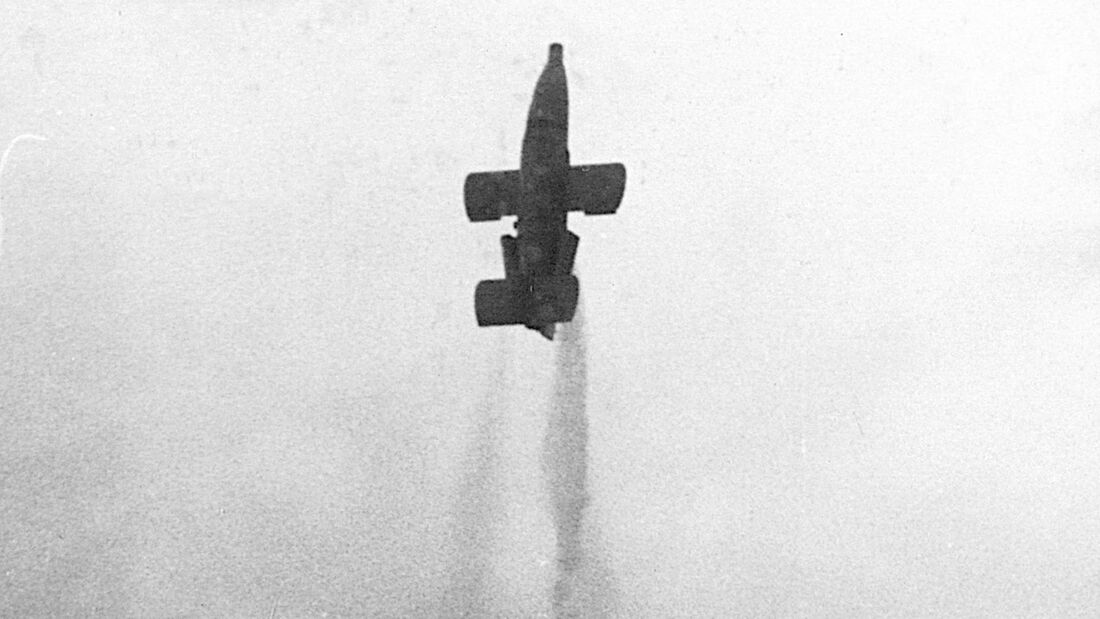
 www.flugrevue.de
www.flugrevue.de
 www.flugzeug-lexikon.de
www.flugzeug-lexikon.de
Arado
Blohm & Voss
Fieseler
Focke Wulf
Heinkel
Junkers
Siebel

Bachem BP 20 / Ba 349 Natter: Die bemannte Rakete aus Holz
Zu den letzten deutschen Entwicklungen des Zweiten Weltkriegs zählt der senkrecht startende Raketen-Abfangjäger Bachem Natter. Der einzige bemannte Teststart der Holzkonstruktion endete am 1. März 1945 mit einem tödlichen Absturz.
Bachem Ba 349 Natter
Attachments
- Joined
- 26 May 2006
- Messages
- 34,917
- Reaction score
- 15,791
I want to remember the competitors,
Arado
Blohm & Voss
Fieseler
Focke Wulf
Heinkel
Junkers
Siebel
Arado E.381
Blohm & Voos BV.40
Fieseler Fi.166 ?
Focke Wulf ?
Heinkel P.1077
Junkers EF.128
Siebel ?
- Joined
- 26 May 2006
- Messages
- 34,917
- Reaction score
- 15,791
Arado E.381
Blohm & Voos BV.40
Fieseler Fi.166 ?
Focke Wulf ?
Heinkel P.1077
Junkers EF.128
Siebel ?
From this book,what were these projects ?.
Attachments
T. A. Gardner
ACCESS: Top Secret
- Joined
- 18 February 2021
- Messages
- 1,159
- Reaction score
- 2,024
Natter: Manned Missile of the Third Reich by Dr. Brett Gooden.
Log into Facebook
Log into Facebook to start sharing and connecting with your friends, family, and people you know.www.facebook.com
Gooden's book on the Natter is definitive. It goes into every detail of the missile--aircraft almost seems inappropriate--and its engagement system. What the Natter, in essence, is is a manned surface-to-air missile.
On launch all the way through approach to target, it is running on a 3-axis autopilot that takes it to within visual range of the target on a radio command link from the ground. The pilot takes over at that point, flies to a firing position, engages the target with air-to-air rockets, then dives away to escape by parachute.
If it were the Japanese, they'd just have the pilot crash into the target and that'd be that. The Germans tried to reuse all the expensive parts of the system.
Gooden's book is way expensive and a bit hard to find. I did get a copy and the UK export paperwork was damn near as thick as the book! But if you can afford a car payment, next month's rent, etc., to buy a book and can find one...
Anyway... The Natter really isn't an "interceptor' or "aircraft" in the conventional sense. It really is just a manned SAM. It's a shortcut to getting a SAM because you don't have a viable guidance system and proximity fuze to use with one and you need the system to work yesterday.
It's an interceptor and an aircraft. Gooden makes a point of mentioning missing material about the period, including pressure suit designs. His book is outstanding but there is more to declassify. This is not the end. I managed to find a copy of the hardcover for about $90.00 plus shipping. Well worth it.
T. A. Gardner
ACCESS: Top Secret
- Joined
- 18 February 2021
- Messages
- 1,159
- Reaction score
- 2,024
It's a manned SAM. The original concept for the Natter lies with Werner v. Braun who proposed a manned surface-to-air missile as early as 1939. Erich Bachem resurrected the idea with the Natter. It took Himmler's intervention to force the Luftwaffe to accept the proposal and build the system.It's an interceptor and an aircraft. Gooden makes a point of mentioning missing material about the period, including pressure suit designs. His book is outstanding but there is more to declassify. This is not the end. I managed to find a copy of the hardcover for about $90.00 plus shipping. Well worth it.
The Natter vertically launches using boosters just as many early SAMs do. It has a liquid fuel sustainer rocket motor, again just like most early SAMs. Control is done by radio link and command from the ground. It would ultimately be tracked by radar along with the target and a very simply analog computer would calculate the intercept point. The only difference is the Natter needs the pilot to detect the target and release the warhead (rockets) to destroy it. Everything after that is simply cost saving measures along with giving what is nearly a suicide weapon a fig leaf of cover that it isn't. Like SAMs, the Natter was also a one-shot deal. One launch, one intercept, and that's it. You need another Natter.
If you were to get rid of the pilot and the space he takes up, you'd end up with something that looks just like the British Brakemine SAM.

It's a manned SAM. The original concept for the Natter lies with Werner v. Braun who proposed a manned surface-to-air missile as early as 1939. Erich Bachem resurrected the idea with the Natter. It took Himmler's intervention to force the Luftwaffe to accept the proposal and build the system.
The Natter vertically launches using boosters just as many early SAMs do. It has a liquid fuel sustainer rocket motor, again just like most early SAMs. Control is done by radio link and command from the ground. It would ultimately be tracked by radar along with the target and a very simply analog computer would calculate the intercept point. The only difference is the Natter needs the pilot to detect the target and release the warhead (rockets) to destroy it. Everything after that is simply cost saving measures along with giving what is nearly a suicide weapon a fig leaf of cover that it isn't. Like SAMs, the Natter was also a one-shot deal. One launch, one intercept, and that's it. You need another Natter.
If you were to get rid of the pilot and the space he takes up, you'd end up with something that looks just like the British Brakemine SAM.

I am aware of the von Braun Interceptor. This is not a suicide weapon. Once it enters the bomber stream it fires its rockets and falls back to Earth. The pilot pulls a lever and the Natter's upper and lower parts separate. The pilot parachutes to the ground. I have seen an unpublished photo of a field with Natters taken after the camouflage netting was removed.
T. A. Gardner
ACCESS: Top Secret
- Joined
- 18 February 2021
- Messages
- 1,159
- Reaction score
- 2,024
It might as well be. Given the rate of pilot deaths and injuries during testing, there was a damn good chance a Natter pilot would die during any given mission. My bet would be close to 50-50, possibly higher. That pretty much makes it a suicide weapon in reality even if it's not supposed to be. Bailing out of a plane, no ejection seat, no particular design aspects to make that easier or safer, isn't an easy feat to do every mission.I am aware of the von Braun Interceptor. This is not a suicide weapon. Once it enters the bomber stream it fires its rockets and falls back to Earth. The pilot pulls a lever and the Natter's upper and lower parts separate. The pilot parachutes to the ground. I have seen an unpublished photo of a field with Natters taken after the camouflage netting was removed.
It also isn't an "interceptor," as this would make it reusable after a mission as an aircraft. That would imply it could land intact and be used again. That too isn't the case. The engine might land intact, or far more likely, be damaged or destroyed during the mission and the rest of the plane is going to be seriously damaged or destroyed necessitating a new airframe for the surviving bits--assuming they can be recovered.
Large picture: The ‘Hasenholz’ near Jesingen. Three launch sites for the ‘Natter’ were set up in this forest; one of them still exists today.
Above: The circular concrete slab with the hole for the mast in the centre and the groove around it for the wheel of the launching frame, which could be turned 360 degrees.
Middle: The hole into which the pole of the simplified launching frame could be inserted.
Right page: The drawing is said to be by Erich Bachem and shows what the launch sites would have looked like. Instead of the metal tower, a wooden pole about 40 cm thick was to be used (the drawing has been slightly rearranged here to make better use of the space). Below: One of the American-captured ‘Natter’ at an exhibition of captured aircraft.
Above: The circular concrete slab with the hole for the mast in the centre and the groove around it for the wheel of the launching frame, which could be turned 360 degrees.
Middle: The hole into which the pole of the simplified launching frame could be inserted.
Right page: The drawing is said to be by Erich Bachem and shows what the launch sites would have looked like. Instead of the metal tower, a wooden pole about 40 cm thick was to be used (the drawing has been slightly rearranged here to make better use of the space). Below: One of the American-captured ‘Natter’ at an exhibition of captured aircraft.
Attachments
- Joined
- 26 May 2006
- Messages
- 34,917
- Reaction score
- 15,791
In my files,
Bachem BP 20 A
In the project description from November 1944, this version is also referred to as the Barak I. For series production, the RLM assigned the designation
8-349. Most of the 'Natter' prototype aircraft built were built as the A version, many of them without Walter engines.
Bachem BP 20 B
To improve range, the BP 20 A was further developed into the B version, which differed from the original model purely externally due to its higher fuselage. Four aircraft of this series were captured from the Americans, whose fuselages were 30 cm longer than the A version.
Bachem BP 20 C
To facilitate transport, the wing on this version was redesigned to be removable. Furthermore, the wing was relocated further back. For assembly, the finished wing had to be inserted into a corresponding opening in the fuselage from the right and secured. Another change was planned for the tail unit. The horizontal stabilizer was mounted on the vertical stabilizer, as had already been tested on the wind tunnel model at the DVL.
Bachem BP 20 A
In the project description from November 1944, this version is also referred to as the Barak I. For series production, the RLM assigned the designation
8-349. Most of the 'Natter' prototype aircraft built were built as the A version, many of them without Walter engines.
Bachem BP 20 B
To improve range, the BP 20 A was further developed into the B version, which differed from the original model purely externally due to its higher fuselage. Four aircraft of this series were captured from the Americans, whose fuselages were 30 cm longer than the A version.
Bachem BP 20 C
To facilitate transport, the wing on this version was redesigned to be removable. Furthermore, the wing was relocated further back. For assembly, the finished wing had to be inserted into a corresponding opening in the fuselage from the right and secured. Another change was planned for the tail unit. The horizontal stabilizer was mounted on the vertical stabilizer, as had already been tested on the wind tunnel model at the DVL.
Similar threads
-
From WW2 Bachem's Ba 349 Natter (Viper) to the cold war
- Started by Dronescapes
- Replies: 0
-
-
-
-

